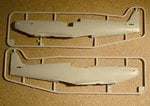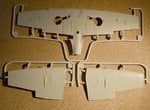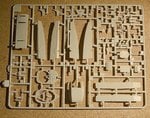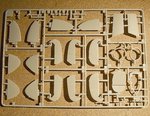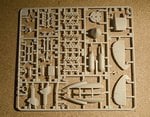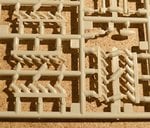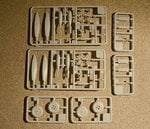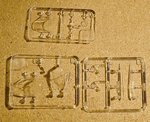Airframes
Benevolens Magister
Revell 1/32nd scale Spitfire Mk.IXc Initial Review.
The new Revell (Germany) kit has just been released, and I received my example today.
Priced at around £27 in the UK, with 154 parts, including optional bombs and other parts, and decals for two aircraft, this kit provides a very affordable alternative to the Tamiya kit, especially if the builder prefers not to display the completed model with all panels open and the engine on display, as this Revell kit does not include an engine or detailed gun bays, but does provide parts for a reasonably detailed cockpit and wheel bays.
As there are quite a few photographs, I'll divide this review into three parts, covering a description of the kit, the parts sprues, and some of the detail areas.
The kit comes in the typical, end-opening box common to Revell Germany, and displays some nice, if perhaps slightly inaccurate box-top artwork, with the reverse of the box showing details shots of a completed model.
The Instruction Booklet is quite impressive, being 'A4' format, in colour, and running to 20 pages, including the two pages of colour scheme and decal placement 'four view' drawings, again in colour, and utilises the standard Revell format of 'exploded' drawings, clearly indicating the construction sequence, with the colour call-out included for Revell paints, a list of which is shown at the front of the booklet.
The decal sheet provides full markings for two aircraft, and includes the main stencils, and decals for the instrument panel, and is nicely printed and in register.
The markings provided cover a camouflaged, full-span aircraft of 416 (RCAF) Sqn, based at Tangmere, UK, in May 1944, and a clipped wing, aluminium finished machine of 601 Sqn., RAF, at Fano, Italy, in November 1944.
The parts appear to be crisply moulded, in a light grey plastic, and exhibit fine surface detail, although, like their recent Mk.II Spitfire, some of the rivet lines might be considered slightly 'heavy' by some, although personally, I feel that, once a primer coat, colour scheme and clear coats have been applied, this should not be a problem. (more on this later.).
The pics below show the box, Instruction Booklet, colour schemes and decals, and the next two posts will show the parts, and describe some of the details areas.





The new Revell (Germany) kit has just been released, and I received my example today.
Priced at around £27 in the UK, with 154 parts, including optional bombs and other parts, and decals for two aircraft, this kit provides a very affordable alternative to the Tamiya kit, especially if the builder prefers not to display the completed model with all panels open and the engine on display, as this Revell kit does not include an engine or detailed gun bays, but does provide parts for a reasonably detailed cockpit and wheel bays.
As there are quite a few photographs, I'll divide this review into three parts, covering a description of the kit, the parts sprues, and some of the detail areas.
The kit comes in the typical, end-opening box common to Revell Germany, and displays some nice, if perhaps slightly inaccurate box-top artwork, with the reverse of the box showing details shots of a completed model.
The Instruction Booklet is quite impressive, being 'A4' format, in colour, and running to 20 pages, including the two pages of colour scheme and decal placement 'four view' drawings, again in colour, and utilises the standard Revell format of 'exploded' drawings, clearly indicating the construction sequence, with the colour call-out included for Revell paints, a list of which is shown at the front of the booklet.
The decal sheet provides full markings for two aircraft, and includes the main stencils, and decals for the instrument panel, and is nicely printed and in register.
The markings provided cover a camouflaged, full-span aircraft of 416 (RCAF) Sqn, based at Tangmere, UK, in May 1944, and a clipped wing, aluminium finished machine of 601 Sqn., RAF, at Fano, Italy, in November 1944.
The parts appear to be crisply moulded, in a light grey plastic, and exhibit fine surface detail, although, like their recent Mk.II Spitfire, some of the rivet lines might be considered slightly 'heavy' by some, although personally, I feel that, once a primer coat, colour scheme and clear coats have been applied, this should not be a problem. (more on this later.).
The pics below show the box, Instruction Booklet, colour schemes and decals, and the next two posts will show the parts, and describe some of the details areas.

